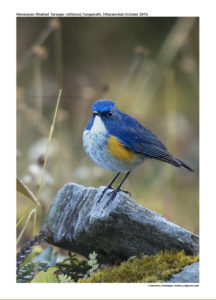Himalayan Bluetail

Himalayan Bluetail Tarsiger (cyanurus) rufilatus
Etymology:
- Tarsiger : tarsos flat of the foot; ger bearing { Flat footed}
- Cyanurus: kuanos dark-blue; ouros -tailed {Dark-blue tailed}
- Rufilatus : rufus-red; latus – flank, side { Red sided}
Vernacular names: Lepcha: Manzhil-pho
It is also known as Himalayan red-flanked bush-robin and Orange-flanked bush-robin
Distribution in India: Resident and Winter Visitor in Himalayan range
Description: Size of 15 cm; wt. of 11–14 g. The male is rich dark blue on head and upperparts, with distinctly paler blue supercilium and shoulder patch, and rich cobalt-blue on rump, uppertail-coverts and outer tail. It has a chin, throat and underparts as white, blue of upperparts extending to breast-sides, breast rather extensively spotted with grey, flanks with distinctive broad orange patch; iris is dark brown; bill and legs are blackish. The female has whitish eyering. It is cold grey-brown above with bright sky-blue rump and tail, remiges are tinged rufous. The chin and throat are white, breast is pale buffy grey-brown, flanks are orange, remaining underparts are white. The juvenile is duller brown with extensive buffish spotting and small streaks, light blue tail, trace of orange on flanks.
Habitat: It is found in Himalayas. It breeds in bush layer of conifer and mixed conifer–oak forest. It is found at 3000–4400 m, not penetrating beyond treeline, but generally in higher, drier habitat. In winter quarters occurs in broadleaf evergreen forest, dense dark undergrowth and thickets, clearings, tree fall gaps with vine tangles, open woodland; commonly seen along tracks; favours ridges and mountaintops.
Food Habits: It eats in Invertebrates, mainly insects and also fruits and seeds when not breeding. It forages on ground and in low bushes, often making short flycatcher-like sallies after flying insects.
Breeding Habits: They breed in Jun-July. Nest a loose cup of grass, moss, hair, wool and feathers, placed in crevice of wall or rock, or in earth bank, pile of stones or on ground. They lay a clutch of 4–6 eggs, incubation period is 2 weeks; nestling period 2 weeks days, but young often flightless for several days after leaving nest; post-fledging dependence as short as 11 day